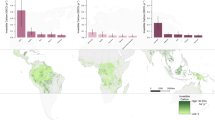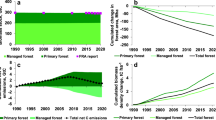Abstract
Land-use change, mainly the conversion of tropical forests to agricultural land, is a massive source of carbon emissions and contributes substantially to global warming1,2,3. Therefore, mechanisms that aim to reduce carbon emissions from deforestation are widely discussed. A central challenge is the avoidance of international carbon leakage if forest conservation is not implemented globally4. Here, we show that forest conservation schemes, even if implemented globally, could lead to another type of carbon leakage by driving cropland expansion in non-forested areas that are not subject to forest conservation schemes (non-forest leakage). These areas have a smaller, but still considerable potential to store carbon5,6. We show that a global forest policy could reduce carbon emissions by 77 Gt CO2, but would still allow for decreases in carbon stocks of non-forest land by 96 Gt CO2 until 2100 due to non-forest leakage effects. Furthermore, abandonment of agricultural land and associated carbon uptake through vegetation regrowth is hampered. Effective mitigation measures thus require financing structures and conservation investments that cover the full range of carbon-rich ecosystems. However, our analysis indicates that greater agricultural productivity increases would be needed to compensate for such restrictions on agricultural expansion.
This is a preview of subscription content, access via your institution
Access options
Subscribe to this journal
Receive 12 print issues and online access
$209.00 per year
only $17.42 per issue
Buy this article
- Purchase on Springer Link
- Instant access to full article PDF
Prices may be subject to local taxes which are calculated during checkout


Similar content being viewed by others
References
Van der Werf, G. R. et al. CO2 emissions from forest loss. Nature Geosci. 2, 737–738 (2009).
Pan, Y. et al. A large and persistent carbon sink in the world’s forests. Science 333, 988–993 (2011).
Houghton, R. A. et al. Carbon emissions from land use and land-cover change. Biogeosciences 9, 5125–5142 (2012).
Ebeling, J. & Yasué, M. Generating carbon finance through avoided deforestation and its potential to create climatic, conservation and human development benefits. Phil. Trans. R. Soc. B 363, 1917–1924 (2008).
Don, A., Schumacher, J. & Freibauer, A. Impact of tropical land-use change on soil organic carbon stocks—a meta-analysis. Glob. Change Biol. 17, 1658–1670 (2011).
Baccini, A. et al. Estimated carbon dioxide emissions from tropical deforestation improved by carbon-density maps. Nature Clim. Change 2, 182–185 (2012).
Kindermann, G. et al. Global cost estimates of reducing carbon emissions through avoided deforestation. Proc. Natl Acad. Sci. USA 105, 10302–10307 (2008).
Nepstad, D. C., Boyd, W., Stickler, C. M., Bezerra, T. & Azevedo, A. A. Responding to climate change and the global land crisis: REDD +, market transformation and low-emissions rural development. Phil. Trans. R. Soc. B 368, 20120167 (2013).
Ghazoul, J., Butler, R. A., Mateo-Vega, J. & Koh, L. P. REDD: A reckoning of environment and development implications. Trends Ecol. Evol. 25, 396–402 (2010).
Gardner, T. A. et al. A framework for integrating biodiversity concerns into national REDD + programmes. Biol. Conserv. 154, 61–71 (2012).
Lambin, E. F. & Meyfroidt, P. Global land use change, economic globalization, and the looming land scarcity. Proc. Natl Acad. Sci. USA 108, 3465–3472 (2011).
Gan, J. & McCarl, B. A. Measuring transnational leakage of forest conservation. Ecol. Econ. 64, 423–432 (2007).
Miles, L. & Kapos, V. Reducing greenhouse gas emissions from deforestation and forest degradation: Global land-use implications. Science 320, 1454–1455 (2008).
Smith, P. Land use change and soil organic carbon dynamics. Nutr. Cycl. Agroecosys. 81, 169–178 (2008).
Guo, L. B. & Gifford, R. M. Soil carbon stocks and land use change: A meta analysis. Glob. Change Biol. 8, 345–360 (2002).
Popp, A. et al. Land-use transition for bioenergy and climate stabilization: Model comparison of drivers, impacts and interactions with other land use based mitigation options. Climatic Change 123, 495–509 (2013).
Wise, M. et al. Implications of limiting CO2 concentrations for land use and energy. Science 324, 1183–1186 (2009).
Reilly, J. et al. Using land to mitigate climate change: Hitting the target, recognizing the trade-offs. Environ. Sci. Technol. 46, 5672–5679 (2012).
Lotze-Campen, H. et al. Global food demand, productivity growth, and the scarcity of land and water resources: A spatially explicit mathematical programming approach. Agric. Econ. 39, 325–338 (2008).
Müller, C. & Robertson, R. D. Projecting future crop productivity for global economic modeling. Agric. Econ. 45, 37–50 (2014).
Bondeau, A. et al. Modelling the role of agriculture for the 20th century global terrestrial carbon balance. Glob. Change Biol. 13, 679–706 (2007).
Schaphoff, S. et al. Contribution of permafrost soils to the global carbon budget. Environ. Res. Lett. 8, 014026 (2013).
O’ Neill, B. C. et al. A new scenario framework for climate change research: The concept of shared socioeconomic pathways. Climatic Change 122, 387–400 (2014).
Van Vuuren, D. P. et al. The representative concentration pathways: An overview. Climatic Change 109, 5–31 (2011).
Meinshausen, M. et al. Greenhouse-gas emission targets for limiting global warming to 2 °C. Nature 458, 1158–1162 (2009).
Harvey, C. A., Dickson, B. & Kormos, C. Opportunities for achieving biodiversity conservation through REDD. Conserv. Lett. 3, 53–61 (2010).
Stickler, C. M. et al. The potential ecological costs and cobenefits of REDD: A critical review and case study from the Amazon region. Glob. Change Biol. 15, 2803–2824 (2009).
Myers, N., Mittermeier, R. A., Mittermeier, C. G., da Fonseca, G. A. B. & Kent, J. Biodiversity hotspots for conservation priorities. Nature 403, 853–858 (2000).
Popp, A. et al. The economic potential of bioenergy for climate change mitigation with special attention given to implications for the land system. Environ. Res. Lett. 6, 034017 (2011).
Popp, A. et al. Additional CO2 emissions from land use change—Forest conservation as a precondition for sustainable production of second generation bioenergy. Ecol. Econ. 74, 64–70 (2012).
Mueller, N. D. et al. Closing yield gaps through nutrient and water management. Nature 490, 254–257 (2012).
Smith, P. et al. How much land based greenhouse gas mitigation can be achieved without compromising food security and environmental goals? Glob. Change Biol. 19, 2285–2302 (2013).
Humpenöder, F. et al. Investigating afforestation and bioenergy CCS as climate change mitigation strategies. Environ. Res. Lett. 9, 064029 (2014).
Dietrich, J. P., Schmitz, C., Lotze-Campen, H., Popp, A. & Müller, C. Forecasting technological change in agriculture—An endogenous implementation in a global land use model. Technol. Forecast. Soc. Change 81, 236–249
Bodirsky, B. L. et al. N2O emissions from the global agricultural nitrogen cycle–current state and future scenarios. Biogeosciences 9, 4169–4197 (2012).
Acknowledgements
The research leading to these results has received funding from the European Union’s Seventh Framework Program under grant agreement no. 282846 (LIMITS), no. 265104 (VOLANTE) and no. 603542 (LUC4C). Funding from Deutsche Forschungsgemeinschaft (DFG) in the SPP ED 178/3-1 (CEMICS) is gratefully acknowledged.
Author information
Authors and Affiliations
Contributions
A.P. designed the overall study; F.H. and M.B. carried out the MAgPIE model runs. A.P. wrote the manuscript with important contributions from F.H., B.L.B., C.M. and M.B.; A.P., F.H., M.B. and B.L.B. analysed the results; F.H., I.W., B.L.B., M.B., J.P.D., A.P., M.S., A.B. and H.L-C. contributed in developing and improving the MAgPIE model; C.M. and S.R. provided biophysical input data from LPJmL; all authors discussed and commented on the manuscript.
Corresponding author
Ethics declarations
Competing interests
The authors declare no competing financial interests.
Supplementary information
Rights and permissions
About this article
Cite this article
Popp, A., Humpenöder, F., Weindl, I. et al. Land-use protection for climate change mitigation. Nature Clim Change 4, 1095–1098 (2014). https://doi.org/10.1038/nclimate2444
Received:
Accepted:
Published:
Issue Date:
DOI: https://doi.org/10.1038/nclimate2444
This article is cited by
-
Potential of land-based climate change mitigation strategies on abandoned cropland
Communications Earth & Environment (2023)
-
Towards scenario representation of adaptive capacity for global climate change assessments
Nature Climate Change (2023)
-
Projected landscape-scale repercussions of global action for climate and biodiversity protection
Nature Communications (2023)
-
Bioenergy-induced land-use-change emissions with sectorally fragmented policies
Nature Climate Change (2023)
-
Global risk assessment of compound hot-dry events in the context of future climate change and socioeconomic factors
npj Climate and Atmospheric Science (2023)



